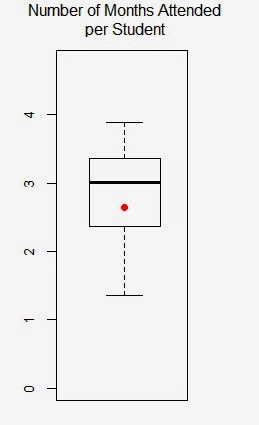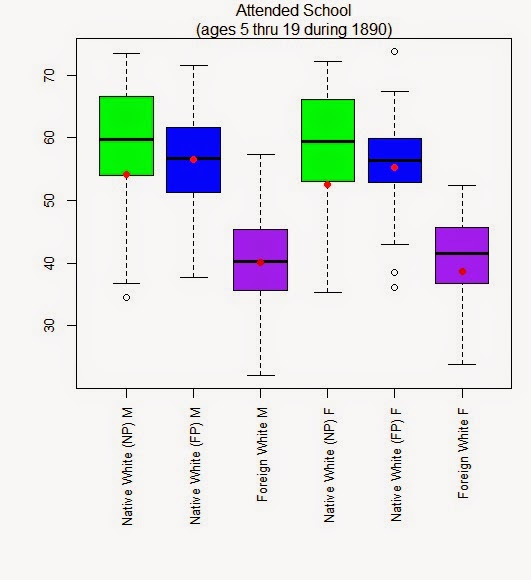Related Posts: Utah’s Teachers and Students, 1870 to 1899; Education Funding in early Utah, 1870-1899; Polygamy versus Democracy
[After a long hiatus I’m back. I’ve just been busy with life: finished my dissertation, graduated, got a job, got married, bought a house. I’m planning on being more active in my blogging for the near future. I have lots of interesting ideas. Hope you like them.]
Introduction
My interest in educational statistics originates from an article written by Stanley Kurtz published in the Weekly Standard titled “Polygamy Versus Democracy: you can’t have both” (June 2006). In it he draws parallels between the United States Government’s struggle to stamp out Mormon polygamy and the current war on terror. “In effect, the fight against polygamy was a slow, frustrating, expensive, ultimately successful campaign to democratize Utah. (The parallels to the war on terror are eerie)” (parenthesis original). Writing further that “the Mormons renounced polygamy and set themselves on the path to democracy.” He also asserted that “Religious leaders schooled their families privately, while most of the territory’s children remained illiterate.” (See Polygamy versus Democracy for data on why his assertions are totally false.) There was also an article written by Damon Linker in The New Republic, “The Big Test” (Jan 15, 2007) where Linker asserted that Mormonism is politically perilous. (My response is here.)
Anyway, my motivation stems from those articles.
So what does school attendance in Utah look like? Overall, very normal.
So for the last several years I’ve been compiling statistical data on Utah and US education and using that data to respond to what they wrote. After having looked at the data I find no evidence that Kurtz’s assertions are true; and the problem with Linkers article is that he ignores the historical record. I’m not exaggerating when I say the historical reasons why the church abandoned polygamy and what Linker asserts are not even similar.
I’ve already published a number posts using my education data. They are listed above. My findings from looking at the attendance data are given below.
I restricted my analysis to ages 5 thru 19 of the white population demographic. The earlier censuses made it easy to get population data on that age group and it is still close to the school ages of 5 thru 18. Also, Utah’s population was predominately white. So I compared Utah’s white population to the same US demographic.
The data presented is based on “attended school” during the census year. That is, if a child attended school during the census year then she was counted. Except for 1890 there is no census data on the number of months of attendance. The 1870 census gives average daily attendance, however, this data is taken from the Report of the Commissioner of Education and is for public schools only. Given that a significant number of Utah children were enrolled in private schools I decided not to include this data. Indeed, the 1888-90 Commissioner of Education report indicates 20.94% of Utah’s school age population was enrolled in private schools—the next highest percentage for that year was New Jersey at 16.81%.
I needed some way to compare the aggregate data of the United States to that of Utah. So I have used the first and third quartiles. That is, if Utah is between the 25th and 75th percentile—the middle 50%–then I consider that to be ordinary. (See here for comparison to a normal distribution.)
The boxplots are for the US states and territories, Utah excluded. Utah is indicated with a red point.
Conclusions
The typical census question that was asked was, “Had the person attended school in the past year?” It only asks if a person had attended school; not how long, or his average attendance. This leads to a startling conclusion. For the census years of 1850, 1860 and 1870 the median for the states and territories of the US was around 50%, so at least half of the white student age population in half of the states and territories of the United States had not attended school! While in the other states and territories attendance was 50% to 90%. The 75th percentile for all the census years varies between 60% and 70%. This means that in 75% of the states and territories of the United States at least 30-40% of the school age population had not attended school.
Utah is below the national median for all years except 1850 and 1860. In all years it fits my definition of ordinary with the exception of 1880. But even in that year it is nearly so.
The 1890 census did asked how many months a person attend school and it reports attendance according to three parentage categories:
- Native white of native parents (child and parents born in US)
- Native white of foreign parents (child born in US, parents born outside US)
- Foreign white of foreign parents (child and parents born outside of US)
I included the “attended school” category for sex and parentage in Figure 7. Utah is ordinary in all categories but two, and in those it is nearly ordinary.
I also estimated the average number of months attended for each 5 to 19 child. Utah is ordinary at about (2.5 months)/(school age child) while the median is about (3 months)/(school age child).
1850

1850 Census Education Question: “Was the person at school within the last year?”
Comments: For the census year of 1850 Utah is above the national median.
1860

1860 Census Education Question: “Did the person attend school within the last year?”
Comments: For the census year of 1860 Utah is above the national median.
1870

1870 Census Education Question: “Did the person attend school within the last year?”
Comments: For the census year of 1870 Utah is below the national median but still ordinary.
1880

1880 Census Education Question: “Had the person attended school in the past year?”
Comments: For the census year of 1880 Utah is a little below Q1. However, I suspect there is a problem with the census data for this year. If we look at the median values for the United States from 1850 to 1890 they are:
1850 45.2%
1860 50.3%
1870 50.8%
1880 63.9%
1890 56.6%
Notice that there is a jump of 13.1 points from 1870 to 1880 and a drop of 7.3 points from 1880 to 1890. I cant explain the unusually large change. However, Utah does not compare badly.
1890

1890 Census Education Question: “How many months did the person attend school in the past year?”
Comments: For the census year of 1890 Utah is below the national median but still ordinary.

Comments: Utah is below the median but still ordinary.
Some comments on how I calculated this data. There were four categories reported in the 1890 census for months attended.
- 1 month or less
- 2 to 3 months
- 4 to 5 months
- 6+ months
I took the number of months attended and multiplied them by the number of students who were in that category. I multiplied the number of students who attended 1 month or less by 1 month to estimate the total months. I multiplied the number of students who attended 2 to 3 months by 2.5; 4.5 for students who attended 4 to 5 months; and 6 for those attended 6+ months. Finally, I summed up each category for each state and territory getting an estimate of the total months attended by the 5 thru 19 population for each state and territory. I divided this by the student age population to get an estimate of the average number of months attended for each 5 thru 19 person.

Comments: Utah is ordinary or nearly so for all parentage and sex.
Parentage categories are as follows.
- Native white of native parents: Native White (NP)
- Native white of foreign parents: Native White (FP)
- Foreign white of foreign parents: Foreign White (FP)
The M and F indicate male and female.